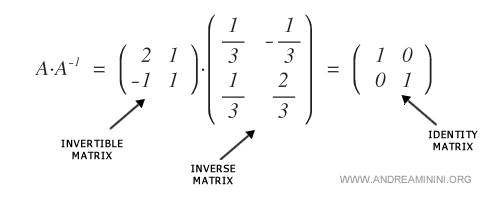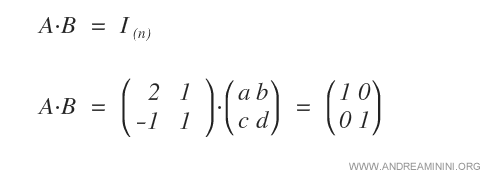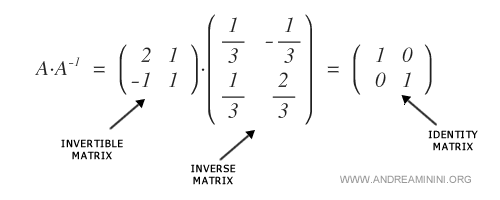Invertible and Inverse Matrices
In linear algebra, a square matrix \( A \) of size \( n \) is called invertible if there exists another square matrix of the same size, known as the inverse matrix and denoted \( A^{-1} \), such that \( A \cdot A^{-1} = I \) and \( A^{-1} \cdot A = I \), where \( I \) is the identity matrix (Identity Matrix).

In linear algebra notation, matrix inverses are represented by the superscript -1, much like the notation for reciprocals in arithmetic.
Note. The concept of a matrix inverse parallels that of a reciprocal for real numbers: every non-zero real number has a reciprocal, \( \frac{1}{a} \), such that \( a \cdot \frac{1}{a} = 1 \). Similarly, an invertible matrix \( M \) has an inverse \( M^{-1} \) satisfying \( M \cdot M^{-1} = I \), where \( I \) functions like the number 1 in real numbers, because multiplying any matrix \( M \) by \( I \) yields \( M \) itself: \( M \cdot I = M \).
Not all matrices are invertible. In fact, many matrices do not have inverses.
The collection of all invertible \( n \times n \) matrices with real entries is denoted \( \text{GL}_n(\mathbb{R}) \) or \( \text{GL}(n, \mathbb{R}) \).
$$ \text{GL}(n, \mathbb{R}) $$
This collection is also known as the general linear group of order \( n \) over the real numbers.
Note. The set \( \text{GL}_n(\mathbb{R}) \) is closed under matrix multiplication, meaning that multiplying any two invertible matrices of the same order results in another invertible matrix. Additionally, the identity matrix \( I \) is part of \( \text{GL}_n(\mathbb{R}) \).
Practical Example of Inverse Matrices
Consider the following matrix:

This matrix is invertible, meaning it has an inverse \( A^{-1} \), so that multiplying \( A \) by \( A^{-1} \) yields the identity matrix \( I_{(2)} \) of the same size.

Calculating the Inverse Matrix: Two Approaches
There are two primary methods to find the inverse of an invertible matrix:
Note. The second method generally requires fewer calculations, making it more efficient, but the first method provides useful insights into the relationship between matrices and linear systems.
Method 1
Given a matrix \( A \), we aim to determine if it’s invertible, and if so, to calculate its inverse \( A^{-1} \).

If \( A \) is invertible, the equation \( A \cdot A^{-1} = I \) holds.

To check if \( A \) is invertible, we multiply it by a matrix \( B \) with unknowns and set this product equal to the identity matrix \( I \).

Next, we carry out the row-by-column multiplication to produce a system of linear equations.

By solving this system, we can determine the elements of the inverse matrix, confirming \( A \) as invertible if a solution exists.

Note. While insightful, this method can become cumbersome for matrices larger than 2x2. The second method is preferred for higher-order matrices.
Method 2
For a 1x1 matrix, the inverse is \( A^{-1} = a_{11}^{-1} \). For larger matrices, the inverse is computed as \( A^{-1} = \frac{1}{\det(A)} \cdot \text{adj}(A) \), where \( \text{adj}(A) \) is the adjugate matrix.
The Existence Theorem states that a matrix is invertible if and only if its determinant is non-zero.

With a non-zero determinant, \( A \) is confirmed invertible. Then, we calculate the cofactor matrix, transpose it to obtain the adjugate, and multiply by \( \frac{1}{\det(A)} \) to find \( A^{-1} \).
Note. If \( \det(A) = 0 \), the matrix is non-invertible, and the calculations end here.
Properties of Inverse Matrices
- Only square matrices can be invertible. If a matrix has an inverse, that inverse is unique.
- The inverse matrix is not simply the reciprocal of individual elements; rather, its elements may vary widely from those of \( A \) and may even be identical to \( A \) in certain cases. Notably, the inverse of the identity matrix is the identity matrix itself.
- If \( A \) is invertible, then \( A^{-1} \) is also invertible, and \( (A^{-1})^{-1} = A \).
- The determinant of \( A^{-1} \) is the reciprocal of \( A \)’s determinant: \( \det(A^{-1}) = \frac{1}{\det(A)} \).
- If \( A \) is invertible, its transpose \( A^{T} \) is also invertible, with \( (A^{T})^{-1} = (A^{-1})^{T} \).
- If matrices \( A \) and \( B \) are both invertible, then their product \( AB \) is also invertible, with \( (AB)^{-1} = B^{-1}A^{-1} \).
- A matrix with a zero determinant is not invertible; only nonsingular matrices (those with a non-zero determinant) have inverses.
- If a matrix has an inverse, it is guaranteed to be unique.
